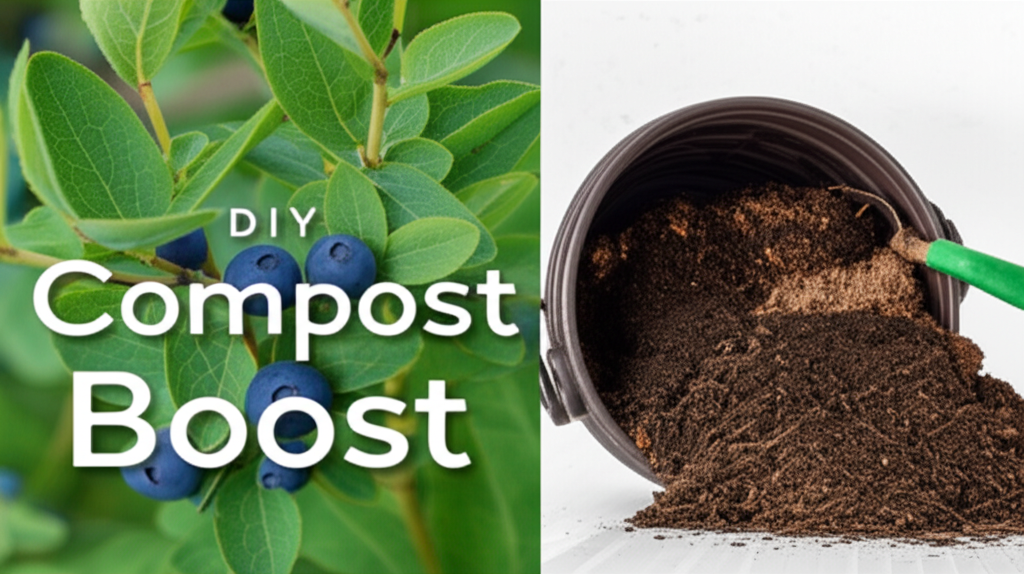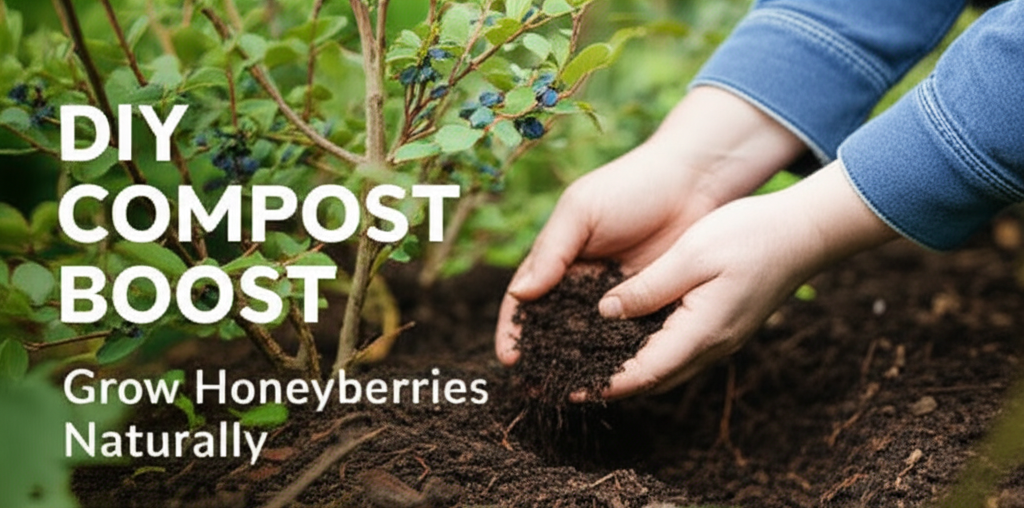Introduction to Honeyberry Composting
The humble honeyberry, also known as haskap or edible honeysuckle, is a rapidly growing favorite among home gardeners. Revered for its incredibly nutritious and antioxidant-rich berries, this hardy shrub thrives in a variety of climates and is relatively low-maintenance. However, to truly unlock its potential for a bountiful harvest, understanding its nutritional needs and providing the right soil conditions is paramount. This is where DIY composting comes in. Composting is not just about waste reduction; it’s about creating a nutrient-dense, living soil amendment that will supercharge your honeyberry plants, leading to healthier growth, increased yields, and more delicious berries.
Why Compost for Honeyberries?

Honeyberry plants, while adaptable, perform best in well-draining, slightly acidic soil rich in organic matter. Compost is the ultimate soil conditioner, offering a myriad of benefits that directly translate to improved honeyberry health and productivity:
- Nutrient Supply: Compost provides a slow-release supply of essential macro and micronutrients vital for plant growth, flowering, and fruit development. This includes nitrogen for leafy growth, phosphorus for root development and flowering, and potassium for overall plant vigor and disease resistance.
- Improved Soil Structure: Adding compost breaks up heavy clay soils, improving drainage and aeration, which is crucial for honeyberry roots. For sandy soils, compost acts as a sponge, retaining moisture and preventing rapid nutrient leaching.
- Enhanced Water Retention: The organic matter in compost significantly increases a soil’s ability to hold moisture, reducing the need for frequent watering, especially during dry spells.
- Beneficial Microorganisms: Compost is teeming with beneficial bacteria, fungi, and other microorganisms that help break down organic matter, make nutrients available to plants, and suppress soil-borne diseases.
- pH Buffering: Compost can help buffer soil pH, making it more stable and suitable for honeyberries, which generally prefer a slightly acidic to neutral pH range.
- Reduced Reliance on Synthetic Fertilizers: By providing a natural and sustainable source of nutrients, composting reduces or eliminates the need for chemical fertilizers, which can be costly and have negative environmental impacts.
Key Facts About Honeyberry Soil Requirements
Understanding your honeyberry’s ideal environment is the first step to successful composting.
| Characteristic | Ideal Honeyberry Condition | Compost Contribution |
|---|---|---|
| Soil pH | 5.5 – 7.0 (slightly acidic to neutral) | Can help buffer pH towards the desired range. |
| Drainage | Excellent, well-draining | Improves structure of clay soils, preventing waterlogging. |
| Organic Matter Content | High | Directly increases organic matter content. |
| Moisture Retention | Consistently moist, but not waterlogged | Enhances the soil’s capacity to hold water. |
| Nutrient Availability | Balanced, slow-release nutrients | Provides a steady supply of essential elements. |
The Art of DIY Composting: What to Compost for Honeyberries
Creating the perfect compost blend for your honeyberries involves a balanced mix of “greens” (nitrogen-rich) and “browns” (carbon-rich) materials. The goal is to achieve a carbon-to-nitrogen ratio of roughly 25:1 to 30:1.
Greens (Nitrogen-Rich Materials):
These materials are moist and provide the nitrogen that “activates” the composting process and fuels the microbial activity.
- Vegetable and Fruit Scraps: Leftover produce from your kitchen, excluding citrus in large quantities (as it can inhibit decomposition) and oily foods.
- Coffee Grounds and Tea Bags: Excellent sources of nitrogen and trace minerals.
- Grass Clippings: Fresh grass clippings are nitrogen-rich, but should be added in thin layers to avoid matting and anaerobic conditions.
- Manure (from herbivores): Well-rotted manure from cows, horses, sheep, or rabbits is a fantastic nitrogen source. Ensure it’s composted thoroughly to kill pathogens and weed seeds.
- Plant Trimmings: Soft, green trimmings from other garden plants (avoid diseased material).
Browns (Carbon-Rich Materials):
These materials provide the carbon backbone for the compost pile, offering energy for the microorganisms and preventing the pile from becoming too wet and smelly.
- Dried Leaves: Fall leaves are a composter’s best friend, providing excellent carbon.
- Shredded Cardboard and Paper: Uncoated, plain paper and cardboard are good sources. Shredding increases surface area for decomposition.
- Straw and Hay: Chopped straw or hay adds carbon and helps with aeration.
- Wood Chips and Sawdust: Use sparingly and preferably from untreated wood. These decompose slowly but are excellent for structure.
- Eggshells: While primarily calcium, they are considered a “brown” in terms of decomposition speed and add beneficial minerals.
Materials to Avoid or Use Cautiously:
Not all organic materials are suitable for compost, especially if you want to feed it to your precious honeyberries.
- Meat, Dairy, and Oily Foods: These attract pests and can create foul odors.
- Diseased Plant Material: Can spread diseases to your honeyberries.
- Weeds with Mature Seeds: May not be killed during the composting process and can infest your garden.
- Pet Waste (dog and cat): Can contain harmful pathogens.
- Treated Wood: Contains chemicals that can harm plants.
- Coal Ash: Can contain heavy metals.
- Large Amounts of Citrus: Can lower the pH too much for some composting microbes.
Choosing Your Composting Method
Several DIY composting methods can effectively produce nutrient-rich amendments for your honeyberry shrubs. The best method for you will depend on your available space, time commitment, and the volume of organic waste you generate.
Hot Composting (Thermostatic Composting):
This method involves actively managing your compost pile to achieve high temperatures (130-160°F or 55-70°C). High temperatures kill weed seeds and pathogens and speed up the decomposition process, producing compost in as little as 4-8 weeks.
Steps for Hot Composting:
- Select a Bin: Use a compost bin with good aeration, such as a three-sided bin, a wire mesh enclosure, or a commercial tumbler.
- Build the Pile: Start with a layer of bulky brown material for aeration. Then, alternate layers of greens and browns, aiming for the 25-30:1 carbon-to-nitrogen ratio. Chop or shred larger materials.
- Moisture: Keep the pile consistently moist, like a wrung-out sponge. Too dry, and decomposition slows; too wet, and it becomes anaerobic and smelly.
- Aeration: Turn the compost pile regularly (every 1-2 weeks) using a pitchfork or compost aerator. This introduces oxygen, which is crucial for thermophilic (heat-loving) microbes.
- Monitor Temperature: Use a compost thermometer to track the internal temperature. When it reaches 130-160°F, maintain it by adding more materials and turning. If it drops, add more greens and turn.
- Finished Compost: The compost is ready when it’s dark, crumbly, smells earthy, and no original materials are recognizable.
Cold Composting (Passive Composting):
This is a much simpler and less labor-intensive method. You simply pile organic materials and let nature take its course. Decomposition occurs, but at a much slower rate, taking anywhere from 6 months to 2 years.
Steps for Cold Composting:
- Choose a Location: Select a spot in your yard that is convenient and out of the way.
- Start Piling: Begin layering your greens and browns as they become available. There’s no strict ratio, but a mix is still beneficial.
- Add Materials: Continue adding kitchen scraps, yard waste, and other compostable materials.
- Water Occasionally: If the pile seems dry, water it down.
- Turn Infrequently: Turning is optional but can speed up the process. Once or twice a year is sufficient.
- Finished Compost: Cold compost will eventually break down into a usable material, though it may take longer and some materials might still be partially identifiable.
Vermicomposting (Worm Composting):
This method uses specific species of earthworms, such as red wigglers, to break down organic materials. It’s ideal for kitchen scraps and produces a highly nutrient-rich compost called “worm castings.”
Steps for Vermicomposting:
- Choose a Bin: Use a specialized worm bin with good aeration and drainage.
- Bedding: Prepare bedding for the worms using shredded newspaper, cardboard, or coconut coir. Moisten it thoroughly.
- Introduce Worms: Purchase red wigglers from a reputable supplier and add them to the bin.
- Feed the Worms: Start by feeding small amounts of fruit and vegetable scraps. Avoid citrus, onions, and oily foods in excess.
- Maintain Conditions: Keep the bin moist and at a consistent temperature (60-70°F or 15-21°C).
- Harvest Castings: After a few months, you’ll have nutrient-rich worm castings, which are an excellent addition to your honeyberry plants.
Pros and Cons of Different Composting Methods for Honeyberries
Here’s a quick comparison to help you decide:
| Method | Pros | Cons |
|---|---|---|
| Hot Composting | Fastest method, kills pathogens and weed seeds, produces high-quality compost. | Requires more effort and attention (turning, moisture, temperature monitoring), needs a larger volume of material to heat up. |
| Cold Composting | Easiest and least labor-intensive, requires minimal management, uses readily available materials. | Slowest method, may not kill all pathogens or weed seeds, finished compost quality can be variable. |
| Vermicomposting | Produces highly nutrient-rich “worm castings,” ideal for kitchen scraps, can be done indoors or in small spaces. | Requires specific types of worms, needs consistent temperature and moisture control, limited volume of material processed. |
How to Use Compost for Your Honeyberry Shrubs
Once you have your finished compost, applying it correctly is key to maximizing its benefits for your honeyberry plants.
When to Apply Compost:
- Spring: As new growth emerges, top-dress around the base of your honeyberry shrubs with a layer of compost. This provides nutrients for the upcoming growing season.
- Fall: After the harvest and as the plants go dormant, a layer of compost can help protect the roots over winter and enrich the soil for the following spring.
- When Planting: Mix compost into the planting hole when establishing new honeyberry plants to give them a healthy start.
Application Techniques:
- Top-Dressing: Spread a 2-4 inch layer of compost around the base of the honeyberry shrub, extending out to the drip line (the outer edge of the branches). Keep the compost a few inches away from the main trunk to prevent rot.
- Incorporating into Soil: When planting, you can mix compost directly into the soil in the planting hole, aiming for about 20-30% compost to 70-80% native soil.
- Compost Tea: For a quick nutrient boost, you can make compost tea by steeping finished compost in water for 24-48 hours, then diluting and applying it as a foliar spray or soil drench.
Troubleshooting Common Composting Issues
Even with the best intentions, composting can sometimes present challenges. Here are a few common issues and how to resolve them:
- Smelly Pile (Ammonia or Rotten Egg Smell): This usually indicates too much nitrogen (greens) or poor aeration. Add more brown materials (leaves, cardboard) and turn the pile to introduce air.
- Pile Not Heating Up: The pile might be too small, too dry, or lack nitrogen. Ensure you have a good mix of greens and browns, that it’s moist, and that the pile is large enough to retain heat.
- Insects or Pests: While some beneficial insects are a sign of a healthy pile, excessive pests can be a problem. Ensure you’re not adding meat, dairy, or oily foods. Burying kitchen scraps in the center of the pile can also help.
- Decomposition is Too Slow: The pile might be too dry, too compacted, or lack sufficient nitrogen. Increase moisture, turn the pile more frequently, and add more green materials. Chopping materials into smaller pieces also speeds up decomposition.
Conclusion: Cultivating Growth with Your Own Compost
DIY composting is an incredibly rewarding practice that directly benefits your honeyberry shrubs. By understanding the principles of composting, selecting appropriate materials, and employing a method that suits your lifestyle, you can create a rich, living soil amendment. This homemade compost will provide your honeyberries with the essential nutrients, improved soil structure, and enhanced moisture retention they need to thrive. The result? Healthier plants, more robust growth, and a significantly larger, more delicious harvest of those prized antioxidant-packed berries. Happy composting, and happy harvesting!


